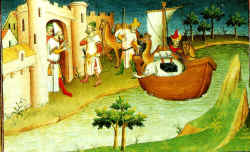
The Technology of Ship Building and Navigation
Seafaring cities: Pisa, Venice, Genoa
|
The Technology of Ship Building and Navigation |
| A new type cargo ship, the
COG, was developed in the later Middle Ages. Broad, with high sides, relatively flat
bottom, and with great stability, the cog increased the ability of merchants to carry
large amounts of cargo. In this picture of a cog, notice
that it is backed into the shore (flat bottom) and notice its cargo. Remember that the
artist has not painted the ship to scale. This
picture is of the port of Naples in the fifteenth century. Notice the number of
cogs in comparison to other vessels. The other vessels are galleys that were the
standard vessels for war and trade from the ancient world to the Renaissance. Can
you see what advantages a galley might have in comparison to a cog? The successor to
the cog was the hulk, which was bigger, carried more cargo, and sailed more efficiently.
The Ships of the Mediterranean and
Northern Europe remained distinctively different until the sixteenth century.
|
|
| Navigation: Trade was limited by navigational instruments and skills. The Arabs brought the magnetized needle to the Mediterranean from China in the twelfth century. By ca. 1275, ships on the Mediterranean were using compasses. The first navigational charts were made at the same time (portolanos). The astrolabe was invented about the same time. Sailors could fairly accurately measure latitude with it but not longitude (this measurement became possible in the eighteenth century with the invention of the chronometer). The astrolabe was an Arabic invention. | |
| Seafaring cities: Pisa, Venice, Genoa
|
Commercial Cities: Milan, Florence, Rome, Siena, Naples, Palermo |